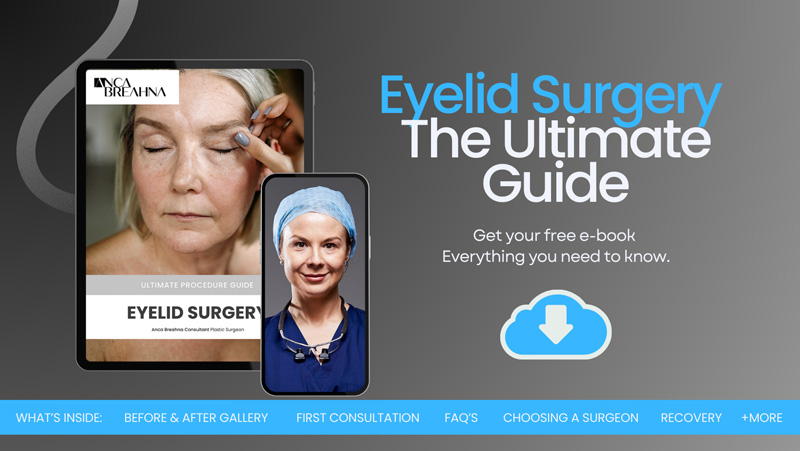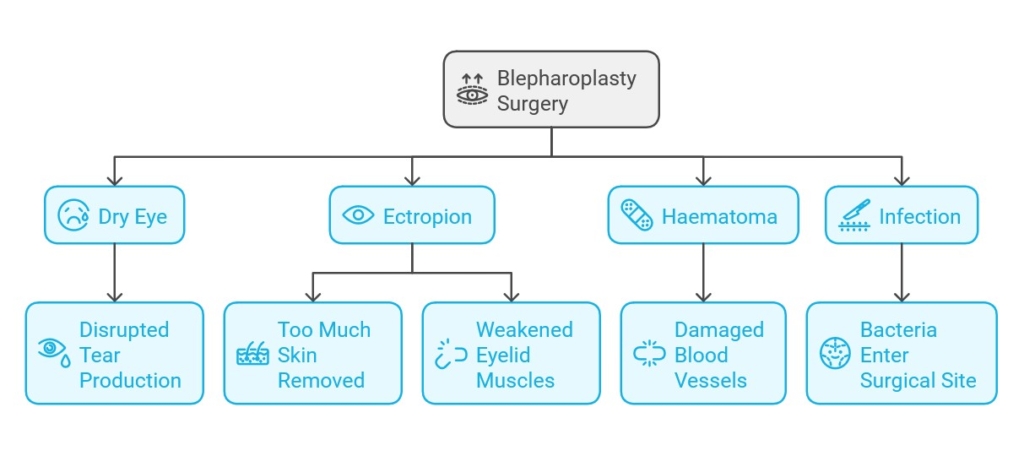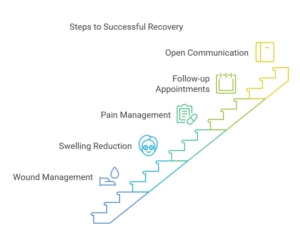
Expert Tips for Blepharoplasty Complications – Dry Eye, Ectropion, and More
Blepharoplasty, or eyelid surgery, can rejuvenate your appearance and improve your vision by removing excess skin and fat from your eyelids. While this procedure offers many benefits, it’s important to be aware of potential complications and how to prevent them.
An experienced plastic surgeon performing blepharoplasty, Chester Consultant Plastic Surgeon Anca Breahna will share her expert tips on minimising the risk of dry eye, ectropion, and other common issues that can occur after the procedure.
Take our Plastic Surgery Quiz to find out if you’d be a good candidate for cosmetic surgery.
Common Complications in Blepharoplasty
Dry Eye
Dry eye is one of the most common complications following blepharoplasty. This condition occurs when your eyes do not produce enough tears or when the tears evaporate too quickly, leading to discomfort, redness, and a gritty sensation in your eyes. After eyelid surgery, you may experience temporary dry eye symptoms due to the disruption of tear production and distribution.
Symptoms of dry eye include:
- Stinging, burning, or scratchy sensation in your eyes
- Stringy mucus in or around your eyes
- Sensitivity to light
- Eye redness
- A sensation of having something in your eyes
- Difficulty wearing contact lenses
- Watery eyes, which is the body’s response to the irritation of dry eyes
- Blurred vision or eye fatigue
If left untreated, dry eye can impact your daily life and lead to more serious complications, such as corneal abrasions or ulcers. Your plastic surgeon will assess your risk factors for dry eye during your consultation and take precautions to minimise this risk during and after your surgery. Your surgeon may also recommend artificial tears, ointments, or other treatments to alleviate symptoms and promote healing.
Ectropion
Ectropion is a condition where the lower eyelid pulls away from the eye, exposing the inner surface of the eyelid and causing irritation, dryness, and discomfort. While rare, ectropion can occur after blepharoplasty if too much skin is removed from the lower eyelid or if the eyelid muscles are weakened during surgery.
Common signs and symptoms of ectropion include:
- Sagging or drooping of the lower eyelid
- Visible redness and irritation of the inner eyelid
- Tearing or watery eyes
- Dryness and discomfort in the eyes
- Sensitivity to light and wind
Ectropion can not only affect your appearance but also lead to more serious eye health issues if not addressed promptly. Your surgeon will use precise surgical techniques to minimise the risk of ectropion and carefully monitor your recovery to ensure proper eyelid position and function. If ectropion does occur, additional procedures might be required to correct the issue and restore your eyelid to its natural position.
Download the Eyelid Surgery Guide

Haematoma
A haematoma is a collection of blood that can develop under the skin after any surgical procedure, including blepharoplasty. This complication occurs when blood vessels are damaged during surgery, and the blood pools in the surrounding tissues, causing swelling, discolouration, and discomfort.
Signs and symptoms of a haematoma include:
- Swelling and puffiness around the surgical site
- Discolouration or bruising that appears more severe than expected
- Pain or tenderness in the affected area
- A firm, lumpy texture under the skin
While small haematomas can resolve on their own with time and proper care, larger ones may require additional treatment, such as drainage or surgical removal. To minimise the risk of haematoma, I use meticulous surgical techniques and provide detailed pre- and post-operative instructions, which may include avoiding certain medications, applying cold compresses, and keeping your head elevated.
Infection
Infection is a risk with any surgical procedure, and blepharoplasty is no exception. While rare, infections can occur if bacteria enter the surgical site, leading to redness, swelling, pain, and discharge. Prompt recognition and treatment of infection are crucial to prevent more serious complications and ensure a smooth recovery.
Signs of infection to watch for include:
- Increased redness, swelling, or pain around the surgical site
- Discharge or pus from the incision
- Fever or chills
- Flu-like symptoms
- Persistent headache or nausea
Expert Tips for Preventing Blepharoplasty Complications
Here are some expert tips to help patients achieve the best possible outcomes and minimise the risk of complications such as dry eye, ectropion, haematoma, and infection:
Pre-operative Measures
One of the most crucial steps in preventing complications is choosing a qualified and experienced surgeon, like Anca. Her extensive training and expertise in blepharoplasty ensure that patients receive the highest standard of care and attention to detail. During the initial consultation, she thoroughly assesses each patient’s individual needs, medical history, and risk factors to create a personalised treatment plan that minimises the likelihood of complications.
Surgical Techniques
Your surgeon’s precision and attention to detail in the operating room are key factors in minimising the risk of complications during blepharoplasty. Anca employs advanced surgical techniques that prioritise the preservation of natural eyelid function and anatomy. By carefully manipulating the delicate tissues around the eyes, she can remove excess skin and fat while maintaining the integrity of the eyelid muscles and tear ducts.
One of the techniques used to reduce the risk of dry eye is the preservation of the orbicularis oculi muscle. This muscle plays a crucial role in tear production and distribution, and by keeping it intact, we can ensure that patients maintain adequate tear function after surgery. Anca also takes great care to avoid over resection of skin and fat, which can lead to complications such as ectropion or a hollow appearance.
To minimise the risk of haematoma, Anca uses meticulous haemostasis techniques during surgery. She carefully controls bleeding by sealing blood vessels and applying gentle pressure to the surgical site. Additionally, she may use advanced technologies such as electrocautery or laser devices to further enhance precision and reduce bleeding.
Post-operative Care
Proper post-operative care is essential for preventing complications and promoting a smooth recovery. Anca provides her patients with detailed instructions on how to care for their eyes following blepharoplasty, emphasising the importance of adherence to these guidelines.
One of the key aspects of post-operative care is proper wound management. Anca instructs her patients on how to gently clean their incisions with a mild soap and water solution, keeping the area dry and protected. She may also recommend the use of antibiotic ointments or eye drops to prevent infection and promote healing.
To minimise swelling and bruising, the recommendation is to apply cold compresses to the eye area for the first 48-72 hours after surgery. It is also recommended to keep the head elevated while sleeping and avoiding strenuous activities or bending down, which can increase pressure in the eye area.
Pain management is another aspect of post-operative care. Anca prescribes appropriate pain medications and provides guidance on their use, ensuring that patients remain comfortable throughout their recovery. She also advises patients to avoid medications that can increase the risk of bleeding, such as aspirin or ibuprofen, unless otherwise directed.
Regular follow-up appointments are necessary to closely monitor each patient’s recovery and address any concerns promptly. Anca encourages her patients to contact her office if they experience any unusual symptoms, such as severe pain, vision changes, or signs of infection. By maintaining open lines of communication and providing prompt attention to any issues, she can intervene early and prevent minor complications from becoming more serious.
When to Seek Medical Attention after Blepharoplasty
While most patients experience a smooth recovery following blepharoplasty, you should be aware of the signs and symptoms that may indicate a complication requiring immediate medical attention. If you notice any of the following issues, contact your plastic surgeon’s office promptly:
- Severe or worsening pain that is not relieved by prescribed medications
- Sudden or excessive swelling, bruising, or bleeding
- Redness, warmth, or discharge from the incision site, which may signify an infection
- Vision changes, such as blurred vision, double vision, or loss of vision
- Difficulty closing your eyes or extreme sensitivity to light
- Fever, chills, or flu-like symptoms
FAQs about Complications in Blepharoplasty
How long does it typically take for dry eye symptoms to resolve after blepharoplasty?
- While the duration of dry eye symptoms can vary from patient to patient, most individuals experience improvement within a few weeks to a couple of months following surgery. Anca may recommend the use of artificial tears, ointments, or other treatments to alleviate symptoms and promote healing during this time.
Can ectropion occur years after blepharoplasty, or does it only develop immediately after surgery?
- In most cases, ectropion develops within the first few weeks following blepharoplasty. However, in rare instances, it can occur months or even years after the procedure. This delayed onset may be due to the natural ageing process, which can cause further relaxation of the eyelid tissues. Regular follow-up appointments with Anca can help detect and address any long-term complications.
Is it normal to experience some numbness around the eyelids after blepharoplasty?
- Yes, temporary numbness or altered sensation around the eyelids is a common side effect of blepharoplasty. This occurs due to the disruption of small nerve endings during the surgical process. In most cases, the numbness gradually subsides over a period of several weeks to a few months as the nerves heal and regenerate.
Can I wear contact lenses immediately after blepharoplasty to address any vision issues related to complications?
- Anca generally advises patients to avoid wearing contact lenses for a period of time following blepharoplasty, typically several weeks. This allows the eyelids to heal properly and reduces the risk of irritation or infection. In the meantime, patients can wear glasses to address any vision concerns. Anca will provide specific guidance on when it is safe to resume wearing contact lenses based on your individual healing progress.
Are there any lifestyle changes I can make to reduce the risk of complications after blepharoplasty?
Yes, certain lifestyle modifications can help minimise the risk of complications and promote a smooth recovery. These include:
- Avoiding smoking, as it can impair healing and increase the risk of infection
- Maintaining a healthy diet rich in nutrients that support wound healing, such as protein, vitamin C, and zinc
- Staying hydrated by drinking plenty of water
- Protecting your eyes from sun exposure and wind by wearing sunglasses and a wide-brimmed hat
- Getting adequate rest and sleep to support your body’s natural healing processes
- Following Anca’s pre- and post-operative instructions closely, including the use of prescribed medications and eye care routines
How common is eyelid asymmetry after blepharoplasty?
- Eyelid asymmetry is a potential complication of blepharoplasty, but the likelihood of experiencing significant asymmetry depends on various factors, such as the individual’s unique anatomy, the extent of the surgery, and the surgeon’s skill and experience. Minor asymmetries are relatively common immediately after surgery due to factors such as swelling, bruising, and individual healing rates. In most cases, these asymmetries resolve on their own as the eyelids heal and settle into their final position, which can take several weeks to a few months. More noticeable or persistent asymmetries are less common, occurring in a small percentage of patients. These may be due to pre-existing asymmetries in the eyelids or facial structure, unexpected scarring or tissue changes during healing, or, in rare cases, surgical technique.
What is revision blepharoplasty?
Revision blepharoplasty is a surgical procedure performed to correct or improve the results of a previous eyelid surgery. This secondary surgery may be necessary if a patient experiences complications, unsatisfactory results, or changes in their eyelids over time following their initial blepharoplasty.
Some common reasons for revision blepharoplasty include:
- Overcorrection or under correction: If too much or too little skin, muscle, or fat was removed during the initial surgery, it can lead to an unsatisfactory appearance or functional issues, such as difficulty closing the eyes.
- Asymmetry: If the eyelids heal unevenly or the initial surgery resulted in noticeable asymmetry, a revision may be needed to achieve a more balanced, symmetrical appearance.
- Eyelid malposition: Complications such as ectropion (outward turning of the eyelid) or entropion (inward turning of the eyelid) may require surgical correction to restore proper eyelid position and function.
- Scarring or irregular contours: Visible scarring, bumps, or hollows along the eyelids may necessitate revision to achieve a smoother, more natural-looking result.
- Ageing changes: As the face continues to age, the eyelids may experience further sagging or drooping, which can be addressed through a revision procedure.
Further Reading about Blepharoplasty with Chester Consultant Plastic Surgeon Anca Breahna
- Read more about What Do Blepharoplasty Scars Look Like?
- Read more about Solutions for Hooded Eyelids
- Read more about Recovery after Eyelid Surgery
- Read more about Blepharoplasty and Contact Lenses
- Read more about Blepharoplasty for Seniors
- Read more about Non-Surgical Alternatives to Blepharoplasty: Do They Really Work?
Medical References for Complications in Blepharoplasty
- Ectropion after blepharoplasty prevention and treatment
- Cosmetic blepharoplasty and dry eye disease: a review of the incidence, clinical manifestations, mechanisms and prevention
- Upper Eyelid Blepharoplasty: Surgical Techniques and Results-Systematic Review and Meta-analysis
- Dry eye in the upper blepharoplasty patient
- The prevention and treatment of lower lid ectropion following blepharoplasty



 Ms Anca Breahna, PhD, MSc, FEBOPRAS, FRCS (Plast) is a highly regarded Consultant Plastic Surgeon specialising in the field of Aesthetic and Reconstructive Plastic Surgery. Anca performs a range of
Ms Anca Breahna, PhD, MSc, FEBOPRAS, FRCS (Plast) is a highly regarded Consultant Plastic Surgeon specialising in the field of Aesthetic and Reconstructive Plastic Surgery. Anca performs a range of 